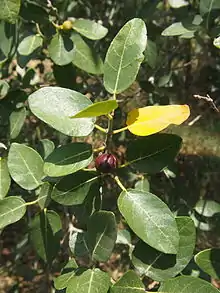Ficus opposita
Ficus opposita is one of several fig species commonly known as sandpaper figs. It is native to the Northern Territory and Queensland in Australia.Other common names include sweet sandpaper fig,[1] sweet fig[1] and the ambiguous "figwood" and "watery fig".[2]
| Sweet sandpaper fig | |
|---|---|
 | |
| Scientific classification | |
| Kingdom: | Plantae |
| Clade: | Tracheophytes |
| Clade: | Angiosperms |
| Clade: | Eudicots |
| Clade: | Rosids |
| Order: | Rosales |
| Family: | Moraceae |
| Genus: | Ficus |
| Subgenus: | F. subg. Sycidium |
| Species: | F. opposita |
| Binomial name | |
| Ficus opposita | |
| Synonyms | |
| |
It grows as either a shrub or small tree.[1] As the figs ripen, their colour changes from green to yellow to reddish-brown and finally, to black.[1] The fruit is edible and palatable, tastier than most other fig species.[3]
It serves as a food plant for the caterpillars of the Queensland butterfly the common- or purple moonbeam (Philiris innotatus).[4]
The leaves on this plant can treat skin infections such as tinea.
References
- Low, T. (1991). Wild Food Plants Of Australia. Australia: Angus & Robertson. ISBN 0-207-16930-6.
- "Ficus opposita". Australian Plant Name Index (APNI), IBIS database. Centre for Plant Biodiversity Research, Australian Government.
- Lindsay, Lenore (March 1992). "Fancy a feast? Try a fig". Australian Plants. 16 (130): 251–52.
- Braby, Michael F. (2005). The Complete Field Guide to Butterflies of Australia. Collingwood, Victoria: CSIRO Publishing. p. 228. ISBN 0-643-09027-4.
This article is issued from Wikipedia. The text is licensed under Creative Commons - Attribution - Sharealike. Additional terms may apply for the media files.
